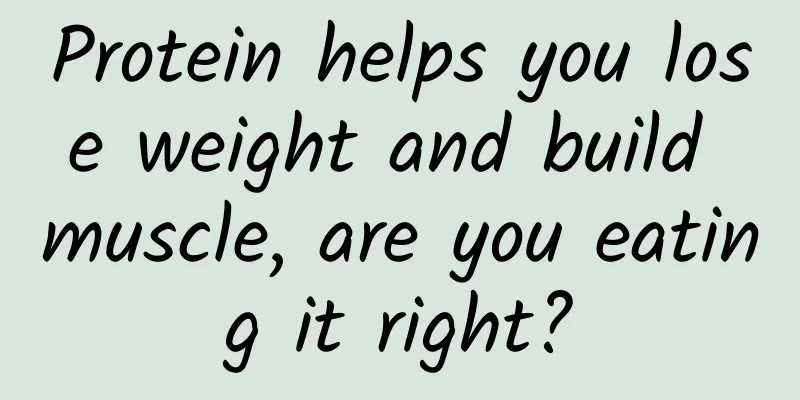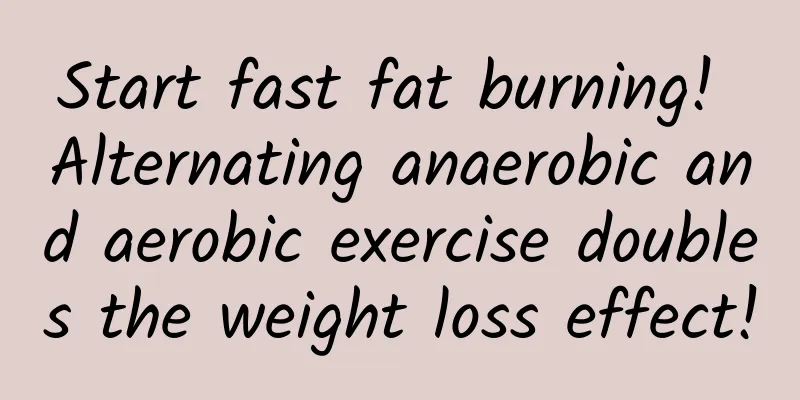Protein helps you lose weight and build muscle, are you eating it right?

|
[Key News Guide]: Are you still feeling very distressed about not being able to lose weight? Do you believe it? In fact, successful weight loss does not depend on how much weight is lost, but on whether body fat is reduced and muscle mass is increased. Only those who maintain exercise and eat the right protein can help reduce body fat, build a lean physique, and achieve the effect of modifying body lines! The following will unveil the mystery of protein for you. What are the health benefits? Tell you how to eat protein correctly? How to stay slim by combining beans, fish, meat and eggs? It’s better to eat smart than to eat too much protein! Identify four major health risks "Protein" is like the architect of the human body. It is listed as one of the three major nutrients of life along with sugars (carbohydrates) and fats. It has functions such as providing calories, repairing tissues and regulating physiological functions. In recent years, it has become an indispensable golden nutrient for athletes to develop muscle strength and make their bodies slimmer. However, everything is "too much is as bad as too little". Eating too much of any nutritious food will become "poison". Wang Jinkun, chairman of the International Health and Nutrition Society, listed four major risks and reminded the public that "it is better to eat smart than to eat a lot"! Crisis 1: Fat accumulation leads to obesity Under normal circumstances, after protein food enters the human digestive tract, it will be broken down into small molecular amino acids, absorbed through the small intestinal mucosa, and transported to the liver through the liver vein. The liver will then synthesize and convert them into proteins needed by the human body, such as albumin, fibrinogen and glycoprotein, for human use. However, Professor Wang Jinkun pointed out that protein contains 4 calories per gram. When protein food is consumed in excess and the body cannot completely metabolize or fully utilize it, the small molecule amino acids sent to the liver will be synthesized into fat. Long-term fat accumulation is not only prone to fatty liver, but also contains up to 9 calories per gram of fat. In this way, it is difficult not to gain weight! Crisis 2: Increasing the burden on the kidneys Nitrogen is produced when the human body breaks down protein into amino acids. The kidneys are the organs that are primarily responsible for metabolizing and filtering nitrogenous waste in the blood. If too much protein is consumed in the diet, it can easily increase the burden on the kidneys and may lead to kidney disease. In addition, patients with renal insufficiency need to consume less protein every day than normal people to avoid excessive accumulation of nitrogenous waste in the blood and causing uremia. In addition, increased protein in the urine also increases the risk of urinary stones. Crisis 3: Edema is a troublemaker The glomerulus in the kidney structure is like a filter. Under normal circumstances, it will capture the nutrients needed by the human body and expel unnecessary waste and water. Professor Wang Jinkun said that if the glomerular function is originally poor, or if excessive protein food intake causes glomerular overwork, the glomerulus' filtering and gatekeeper functions will be disrupted, causing a large loss of protein needed by the human body. Protein itself has a strong water-retaining property, and people with renal dysfunction cannot metabolize water normally. Once the two are combined, it is more likely to cause edema. Crisis 4: Osteoporosis is a common disease Analyzing the structure of protein molecules, it can be found that they carry two negative charges. When excess protein in the human body is metabolized and excreted, they will, like human hands, tightly grasp the calcium carrying two positive charges, causing blood calcium imbalance. Once the calcium in the diet is insufficient, the calcium stored in the bones will be used, resulting in osteoporosis and brittleness. It’s better to eat smartly than to eat a lot! This is just the right amount of protein If you don’t eat enough protein, your body will find it difficult to maintain normal functions; if you eat too much protein, it will increase the burden on your body. After all, how much protein should each person eat every day? Professor Wang Jinkun said that in principle, when the body functions normally, each person's daily protein intake should account for 10% to 20% of the total calories, with the remaining carbohydrates accounting for 50% to 60% and fat accounting for 30%. Each gram of protein contains 4 calories. If an adult needs 2,000 calories per day, a total of 50 to 100 grams of protein is needed. If you do further calculations, you will need to adjust your protein intake based on your personal weight and needs. Generally speaking, the daily protein intake formula for a normal adult is "per kilogram of body weight x 1 gram of protein". That is to say, for a person weighing 60 kilograms, the recommended daily protein intake is 60 grams, 20 grams each for breakfast, lunch and dinner. However, Professor Wang Jinkun reminds the following three groups to pay special attention to their protein intake. 1. People who are controlling their weight: The daily calorie intake of people who are controlling their weight should be 300 to 500 calories less than that of the average person. If the daily calorie intake for weight management is 1,500 calories, the protein ratio should be 37.5 grams to 75 grams. However, protein does not require the assistance of insulin and can be directly metabolized and absorbed by the human body, quickly converted into energy, and can increase satiety. Therefore, it is recommended that the protein intake for three meals should be maintained at "20-20-20" grams. 2. People who exercise a lot: People who often engage in gravity training, weightlifting, half or full marathon and other high-intensity exercises need to strengthen muscle endurance training and have a higher demand for protein. It is recommended that the daily intake formula be changed to "1.5 to 2 grams of protein per kilogram of body weight". In addition to supplementing protein with all three meals, don’t forget to supplement 20 grams of protein each time you exercise for 30 to 40 minutes to help replenish energy and repair damaged tissues. 3. People with weak muscles: Protein can promote muscle building. People with muscle weakness or sarcopenia, such as the elderly, also need to consume more protein than the average person, with 30 grams recommended per meal. Uncovering the mystery of protein has many health benefits Protein has 8 essential amino acids that are taken from the diet Protein is a complex organic compound and an essential nutrient for the human body. Hong Ruopu, a nutritionist at Taipei City United Hospital Zhongxiao Branch, pointed out that there are estimated to be more than 100,000 types of proteins in the human body, which are mainly composed of amino acids. Due to the different combinations and arrangements of amino acids, various types of proteins are formed, which play an important role in the health and nutrition of the body. The proteins needed by the human body are composed of amino acid compounds. Among them, 22 amino acids, when combined in different amounts, can produce various proteins with different properties; another 14 can be produced by the human body, and the remaining 8 must be obtained from the diet. These 8 amino acids include: phenylalanine, methionine, threonine, valine, tryptophan, leucine, isoleucine, and lysine. These are the so-called “essential amino acids”. Growing children need two more essential amino acids, including arginine and histidine. Nutritionist Hong Ruopu emphasized that the effects of amino acids on the human body include: providing nutrition to the organism, regulating physiological functions, enhancing immunity, maintaining cardiovascular function, improving liver and kidney function, reducing the damage of chemotherapy and radiotherapy, promoting hormone secretion, and synthesizing protein. The biological value of protein is determined by the balance of essential amino acids Generally speaking, the biological value of protein is determined by the balance of the eight essential amino acids needed by the human body. The more balanced the protein, the higher its biological value (the closer to 100 the better, which is called a "complete protein"). For example: beans, fish, meat, eggs and milk are all complete proteins. However, "semi-complete protein" cannot promote human growth, development and metabolism, it can only maintain life. For example, animal chicken feet are collagen, which is an "incomplete protein" that cannot help promote the growth and development of the human body and has extremely low physiological value. A Super Comparison of Essential Amino Acids for Protein 1. Phenylalaine: can improve brain function and improve depression symptoms. The raw material for nerve cells to produce the neurotransmitter "norepinephrine", which can keep us mentally alert, improve memory and fight depression.
2. Methionine: It can prevent hair, skin and nail diseases, lower cholesterol levels, reduce liver fat, prevent poisoning, and help the kidneys excrete toxins.
3. Threonine: It can promote growth and is an important component of human collagen and tooth enamel. It can prevent fat accumulation in the liver and promote gastrointestinal function.
4. Valine: It can regulate the balance of nitrogen in the blood, promote brain power, improve muscle coordination and stabilize emotions.
5. Tryptophan: It is a natural mental relaxant that can improve sleep, reduce anxiety and worry, improve headaches, enhance immune function, and reduce cardiovascular disease. Tryptophan is the raw material for synthesizing serotonin. Therefore, a lack of tryptophan can easily lead to depression, anxiety and binge eating tendencies.
6. Leucine and Isoleucine: can promote growth and assist nerve function. It helps the body's energy metabolism, brain and nerve conduction.
7. Lysine: It can help calcium absorption, promote collagen formation, help the production of antibodies, hormones and enzymes, and can assist in the treatment of herpes simplex.
Two essential amino acids for protein growth in children 1. Arginine: It can enhance the body's immunity against bacteria, viruses and tumors, promote the secretion of growth hormone, help wound healing and liver cell regeneration. Increase muscle mass and reduce fat accumulation.
2. Histidine: It is one of the main components of human hemoglobin and can be used to treat rheumatoid arthritis, allergic diseases, and anemia. Lack of histidine can cause hearing loss.
Recommended protein intake: beans, fish, meat, eggs Balanced intake of beans, fish, meat and eggs, half of which should be plant protein Protein is found in all kinds of food, but the proportions vary. Among the six major food categories, beans, fish, meat, and eggs are rich in protein and are the main source of protein intake. However, many people are curious whether the order of "beans, fish, meat and eggs" also implies the priority of eating protein foods? Nutritionist Cheng Hanyu said that the four foods of "beans, fish, meat and eggs" must be consumed in a balanced manner. Although beans are ranked first, it does not mean that they are the best choice. It is mainly to remind modern people who eat more meat not to forget that beans are also a good source of protein. The intake of plant and animal protein foods should account for half each, which is less likely to cause a burden on the body. How to eat plant protein and animal protein Plant-based proteins reduce disease risk; utilization rate low So, what are the benefits of plant protein foods, such as soybeans, edamame, black beans, etc.? These foods are completely cholesterol-free and very low in saturated fat. They also contain dietary fiber, vitamins, minerals, phytonutrients and other benefits that help reduce the risk of cardiovascular disease, cancer, obesity and diabetes. However, the digestion and absorption rate of plant protein is relatively low. Vegans who do not consume meat and dairy products are also prone to lack of nutrients such as vitamin B12, vitamin B2, zinc, and iron. High utilization rate of animal protein can easily increase cardiovascular burden As for animal protein, such as beef, pork, and fish, under the premise of eating non-processed foods, these foods have a relatively high absorption rate and are also high in iron and zinc content; iron can prevent anemia, and zinc can promote wound healing. However, animal protein foods also contain cholesterol and are relatively high in saturated fatty acids. Excessive intake can easily increase the chance of developing cardiovascular disease. Therefore, nutritionist Cheng Hanyu recommends that the ratio of plant protein to animal protein should be 50% each. At the same time, it is recommended to choose low-fat foods, such as lean meat and low-fat milk, and it is recommended to eat one egg a day. In addition, whether it is meat or vegetables, protein intake should be mainly natural foods, and processed foods should be avoided, such as ham, sausage, bacon, smoked chicken, bean curd, etc., to ensure good health. Decide on the right amount of beans, fish, meat and eggs based on your calorie needs Now that we know the principle of balanced intake, how should we determine the right amount of food? According to the Ministry of Health and Welfare's daily dietary guidelines, one should consume 3 to 8 servings of "beans, fish, meat, and eggs" every day (one serving is about 1/4 the size of a palm). For example, for a healthy woman who is 30 years old, 159 cm tall and weighs 52 kg, and spends most of her time in the office working on a computer (the intensity of her life activity is "slightly low", with a daily calorie requirement of about 1,650 calories), it is recommended that she consume 4 to 5 servings of beans, fish, meat, and eggs every day. One serving is equivalent to a 240cc cup of unsweetened soy milk, 30-35 grams (about one tael) of meat, and an egg. How to choose high-quality protein? Essential amino acid conversion efficiency is the key In fact, even if they belong to the same category of foods such as beans, fish, meat and eggs, the protein composition of each food is not the same. Protein is composed of amino acids. If the food you ingest contains complete essential amino acids that the human body cannot produce on its own, or is a food with a higher "biological value" (which means that the protein is more efficiently converted into body tissue after being absorbed by the human body), it can be called high-quality protein. This includes beef, pork, fish, eggs, milk, etc., which are absorbed and utilized by the human body very efficiently. Beans/choose edamame and soybeans If you want to take in high-quality protein, among the four categories of "beans, fish, meat, and eggs", it is recommended that you choose edamame, which is immature soybeans. It is rich in high-quality protein, has high nutritional value, and is less likely to be genetically modified. It is delicious and safe. In addition, soybeans and black beans are also rich in protein. Fish/Mackerel and Saury Recommended fish include mackerel and saury, which are rich in Omega-3 fatty acids, which help lower cholesterol and blood pressure and prevent cardiovascular diseases. They also have anti-inflammatory and immunity-enhancing effects. In addition, dried fish can be eaten together with the fish bones, so that calcium can be absorbed at the same time. Meat/Choose low-fat chicken Regarding meat, nutritionist Cheng Hanyu recommends choosing chicken, which has a relatively low fat content. The essential fatty acids contained in chicken fat are also higher than those in other meats. In addition, chicken is rich in unsaturated fatty acids and is a source of high-quality protein. Eggs/Easy to obtain eggs As for eggs, since they are easy to obtain and contain nutrients such as B vitamins, you can get other benefits while taking in high-quality protein. Exercise to reduce body fat ≠ weight loss Supplement protein after exercise to create a lean body More protein is not always better. Excessive intake leads to decreased utilization However, people are reminded that no matter what kind of protein food it is, more is not necessarily better. Many people believe that if they want to build strong muscles or make their body slimmer, they need to consume a lot of protein. However, nutritionist Cheng Hanyu said that excessive protein intake will cause a decrease in protein utilization; moreover, when starchy food intake is insufficient, protein utilization will also deteriorate. Protein helps build muscle and needs to be supplemented in large quantities only during intense exercise In terms of fitness, since protein can repair muscle tissue damaged after exercise, supplementing protein in moderation can indeed achieve the effect of "nourishing muscles". However, usually only people who engage in intense exercise such as weight training and marathons need to deliberately supplement larger amounts of protein to repair muscles. For ordinary people who just do exercises such as brisk walking, jogging, swimming, and cycling, they do not need to deliberately supplement a large amount of protein. They only need to consume 3 to 8 servings of protein foods based on the daily calorie requirements. Excess protein turns into fat. A single food cannot make you slim. On the other hand, some people mistakenly believe that they can have a slim figure by eating less starch and more protein. Nutritionist Cheng Hanyu pointed out that this is actually a wrong concept. In addition to reducing protein utilization, excess protein will also be converted into fat, which may lead to weight gain. Moreover, excessive protein will increase the burden on organs such as the liver, kidneys, and cardiovascular system, which is not good for health. People are reminded that pursuing a slim figure cannot rely on a single food alone. A balanced diet, moderate intake, and moderate exercise are the correct approaches. Build a slim body by exercising to reduce body fat and increase muscle mass by adding protein In fact, if you want to have a slim body, you are not limited to reducing the number of pounds. Reducing body fat does not mean losing weight. The key is to "reduce body fat and increase muscle mass." To achieve this goal, you must combine exercise with burning fat and reducing body fat. At the same time, you can replenish the muscles lost through exercise through protein. As muscle mass increases, the basal metabolic rate will also increase, which will help to create a lean physique and make your body slimmer. Through the above methods, you can reduce fat and increase muscle mass, so that you can become slimmer and it is also beneficial for weight management. Eat protein recipes to get slim If you plan to have a slimmer figure, you might as well cleverly incorporate protein foods into your three meals a day. This way you will have a chance to lose body fat and have a slimmer figure. Nutritionist Cheng Hanyu has designed a set of three meals a day recipes specifically for people with the above needs, that is, adult women with overweight BMI values (greater than 24), which can provide the six essential nutrients for the human body and be combined with protein foods, as a reference. [Keep your body in shape with a protein-rich daily diet] However, nutritionist Cheng Hanyu also reminded that the above recipes are for reference only, and the relevant vegetables and fruits can be replaced appropriately according to the season and personal preference. In addition, since the grapefruit in dinner will interact with the calcium channel blocker drugs in high blood pressure medications, people with high blood pressure are advised to replace grapefruit with other fruits. As for people with chronic kidney disease or renal insufficiency, they cannot effectively absorb the protein sources and amounts recommended in this recipe due to poor protein metabolism. If you want to lose weight, you should seek help from a professional doctor or nutritionist to design a balanced diet that suits you. |
<<: Drink 7 slimming soups to reduce internal heat and dryness in autumn
>>: The fattest person in Asia? ! 2 steps to reduce belly fat!
Recommend
How much does it cost to see a doctor in the early stage of pelvic peritonitis?
Many female patients want to know the cost of tre...
Is it really necessary to prepare the cervix before surgical abortion in early pregnancy? Let's find out
Cervical preparation (promoting cervical ripening...
How to treat pelvic inflammatory disease
How is pelvic inflammatory disease treated? Pelvi...
Common medication misunderstandings in patients with hyperprolactinemia
Hyperprolactinemia is a common disease, and Chine...
Can threatened miscarriage heal itself?
Drugs, environmental factors, etc. can cause thre...
What are the symptoms of cervical erosion in women? Women with cervical erosion should pay attention to these 3 symptoms
Is increased vaginal discharge the main symptom o...
Can uterine effusion be cured quickly?
Can uterine effusion be cured quickly? Uterine ef...
Can abortions five years ago be detected? Women who want to have an abortion must know these common sense
Everyone makes mistakes, after all, no one is a s...
The first choice hospital for hyperprolactinemia
Hyperprolactinemia is mainly transmitted through ...
Mediterranean diet plus olive oil to avoid "old bones"
The Mediterranean diet is a long-standing healthy...
There are two main methods for diagnosing vulvar leukoplakia.
In order to accurately choose the treatment metho...
What tests should be done for habitual miscarriage? You need to do these 3 tests
If habitual miscarriage occurs, the first thing t...
What are the main symptoms of cervicitis in women? There are three main symptoms of cervicitis in women.
Cervicitis is the most common type of inflammatio...
Contagious issues with Bartholinitis
Bartholinitis is a common gynecological disease i...
Which diseases should vulvar leukoplakia be differentiated from?
What diseases should vulvar leukoplakia be differ...









